
Related
Secretary of State Colin Powell headed for Colombia yesterday to shore up US support for President Andres Pastrana.His three-day trip to the region comes in the face of mounting popular opposition to the US and Colombia’s militarization of the so-called war on drugs. [includes rush transcript]
The US is providing an estimated $1.3 billion in aid to the Colombian military as its contribution to President Pastrana’s “Plan Colombia.” The plan, which focuses on aerial fumigation and eradication of coca fields, is opposed by Colombia’s neighbors, much of its own population and international human rights and environmental groups.
Many human rights groups say that US anti-drug assistance is a fig leaf for its support of the brutal Colombian military’s war against leftwing guerrilla groups and civil society organizations.
Powell is also expected to announce a resumption of the US anti-drug flights that led to the killing of two US citizens by the Peruvian air force in May.
Guest:
- Mario Murillo, host of the national radio show Our Americas. He just returned from a two-month trip to Colombia.
Transcript
AMY GOODMAN:
Secretary of State Colin Powell headed for Colombia yesterday to shore up US support for President Andres Pastrana. His three-day trip to the region comes in the face of mounting popular opposition to the US and Colombia’s so-called war on drugs.
The US is providing an estimated $1.3 billion in aid to the Colombian military as its contribution to “Plan Colombia.” The plan, which focuses on aerial fumigation and eradication of coca fields, is opposed by Colombia’s neighbors, much of its own population and international human rights and environmental groups. Many human rights groups say the US anti-drug assistance is a fig leaf for its support of the brutal Colombian military’s war against guerrilla groups and civil society organizations.
Powell is also expected to announce a resumption of the US anti-drug flights that led to the killing of two US citizens by the Peruvian air force in Peru in May.
We’re joined on the phone right now by Mario Murillo. He is host of the national radio program Our Americas, and he’s just returned from a two-month stay in Colombia. Welcome to Democracy Now!, Mario.
MARIO MURILLO:
Thank you so much, Amy. It’s good to be on, notwithstanding the fact that you’re not broadcasting in New York, where the people who are running the show there seem not to understand the significance of the program and the role that it plays in trying to inform the public.
AMY GOODMAN:
Well, I want to thank you very much for being with us. The significance of Secretary of State Colin Powell’s trip?
MARIO MURILLO:
Well, Colin Powell is basically going there to check on the United States’s investment. In fact, Marc Grossman, the Sub-Secretary of State of Interhemispheric Affairs, last week actually called it an investment when he visited down to Colombia with a number of other US delegates. And as you pointed out in your introduction, the investment being $1.3 billion in assistance, primarily military assistance, last year, and now they’re talking about the Andean Regional Initiative, which is calling for $880 million for the next fiscal year, which is also primarily going towards Colombia and the military.
Now, his visit is coinciding with a number of major developments, things that we were watching with considerable concern while we were down there. One, of course, is the ongoing protests and the denunciations of this aerial eradication campaign used specifically in the South, the fumigations that are carrying out against the small coca plantations and poppy plantations in the name of trying to stem the flow of drugs, but in effect it’s really having a detrimental impact, talking to a number of different communities, a number of different representatives from around the region in southern Colombia, talking about how it has impacted the environment and the health of the area. So there’s a lot of resistance to it, including on the — a number of governors from southern Colombia, who have been mounting pressure on the Colombian government to stop the fumigations.
But it’s also coming in the wake, or I should say in the midst, of a major military offensive that’s being carried out in southern Colombia in the departments of Meta and in Guaviare province. I was in Guaviare last August, just a few months ago — about a month ago, and this was an area that in 1996 was heavily focused — the US was totally focused on the aerial fumigations there, but it’s kind of fallen out of the public spotlight over the last several years, especially in wake of the Plan Colombia and the focus on Putumayo, a province a little bit to the west of Guaviare.
But since August 7, the Colombian military, with the support of the US, has been carrying out a major offensive against guerrilla strongholds in southern Colombia, which has been an area that’s totally been controlled by the FARC for many, many years. They’re going in there, they’re carrying out their aerial raids of communities and of alleged guerrilla strongholds, while the anti-narcotics police are going in and destroying the many drug processing plants in the area. And what this is being presented as to the Colombian public, with great video footage from the Colombian national television, is that the Colombian government is doing what it has to do to stem the flow of narco-trafficking, and they’re doing it by tackling and attacking directly the guerrillas of the Revolutionary Armed Forces of Colombia. And what they’re saying right now is we can continue doing it and we could win this war militarily, if only we got a little bit more support, not only from Washington, but also from the Colombian Congress and the budget that — the budget process that’s underway right now. So it’s no coincidence that Colin Powell is going there to check on US investment as this major military offensive is taking place in the south.
And then, finally, it also comes as the right wing in Colombia and especially the military and the many sectors of the political ruling class in Colombia, they’re calling on an end to the so-called demilitarized zone, which I’m not sure — I’m sure your listeners are familiar with, the Switzerland-sized territory in southern Colombia, which has been ceded to the FARC back in 1999 as a way to jumpstart peace talks. And for months now, they have been clamoring to end that, saying that that hasn’t led to any concessions on the part of the FARC and that it’s an — now it’s time for all-out war. And Colin Powell, the same day that I left Colombia, just about two weeks ago, he was actually quoted as having criticized Pastrana for continuing with this demilitarized zone. So it’s no coincidence that he’s going there at this point in time.
AMY GOODMAN:
We’re talking to Mario Murillo, again, host of the radio program that airs around the country, Our Americas, just back from Colombia.
Mario, on the front page of the Washington Post today — “Murders Follow a Massacre, Colombian Militia Targets Investigators” — Scott Wilson writes, “Less than three weeks before she was shot twice in the face and left to die near her front porch, Yolanda Paternina feared that perhaps she’d gone too far. ‘They are going to kill me,’ [Paternina] told a colleague in the attorney general’s office.
“Her prediction came true in the early evening of Aug. 29. Crossing the street in front of the house where she rented a room, the 50-year-old prosecutor and mother of two turned to answer a stranger who called her name. The man fired twice, then walked to a waiting motorcycle and roared away.
“With those shots, Paternina became the third member of the attorney general’s office to die or disappear this year while investigating the January massacre of twenty-six people by a paramilitary force in the village of Chengue. Two undercover agents investigating the crime disappeared in May at a paramilitary roadblock and are presumed dead.”
They’re talking about the United Self-Defense Forces of Colombia, or AUC, the rightwing paramilitary group that often works in tandem with the Colombian military, now on the State Department’s terrorist list. Can you talk about them and the significance of, for the first time, a paramilitary group in Colombia being put on the terrorist list of the United States?
MARIO MURILLO:
Well, first, to respond to your latest question or latter question about the fact that it’s on the State Department list of terrorist organizations, I think it’s necessary — it was absolutely necessary for that to happen, especially given the fact that Colin Powell is going on this very high-profile visit to Colombia.
There has been considerable criticism that Plan Colombia is focusing in — in the name of the drug war, is focusing too much attention on southern Colombia and in particular the areas where the FARC are very powerful, the guerrillas are very powerful. So it’s been described as a counterinsurgency strategy. The United States and the Colombian government for years, for the last two or three years, have been trying to sell this program as a comprehensive approach that’s counter-drugs and that it’s not counterinsurgency. So there is no — and the fact of the matter is is that the AUC, the Self-Defense Forces of Colombia, the paramilitaries, have for years been the main beneficiaries of the drug trade. So for the United States to go into Colombia with such a major military project, they cannot justify that package without calling attention to the role that the paramilitaries are playing, not only in the drug trade, but in human rights violations.
Now, in terms of their connections with the military, it’s so amazing how over and over again the Colombian media, as well as the US media, in echoing what the Colombian government officials say, refer to apparent links or supposed links or alleged links between the paramilitaries and the Colombian armed forces. And over and over again, it is clear that those links continue, that those links are very systematic, and that it is part of an overall strategy to win and to gain back major chunks of territory throughout the country.
I’ll just give you one example. The most recent massacre that was — that had such atrocious proportions took place in the Naya in the town of Alto Naya, which is in the northwest part of Cauca, which is a province in the western part of Colombia, southwestern part of Colombia. That massacre, there were twenty-two people who were killed and hundreds of people who were forcibly displaced as a result of that. The AUC recognized that actually forty-two people were killed. So the Colombian government statistics say twenty-two people were killed. The AUC, Carlos Castaño, the head of the paramilitaries, actually acknowledged that they killed forty-two people in Naya, calling it a wonderful act, a glorious act of patriotism.
Now, what happened in that situation is very complicated and clearly points to the ongoing links between the paramilitaries and the army. The ELN, the other guerrilla organization in Colombia, had carried out a kidnapping, a major kidnapping in that area. They brought the people that they had kidnapped to Alto Naya, to the town where this massacre took place. Now, the ELN has a history of operating in that area, and they are — obviously they meld, they blend in with the population regularly. So when this kidnapping took place, they took the people there to Naya. The military came in in pursuit. They started asking people, they started questioning, interrogating individuals in the community, “What happened? Where are they? Where are they holding the kidnap victims?” And the people obviously for many reasons wouldn’t talk, one because of security, two because it’s not easy to point out where they’re going to put out — where they’re putting kidnap victims. I mean, it’s not like the ELN came in and publicly said, “Hey, here we have these victims that we’ve kidnapped.”
So they couldn’t collaborate. And what the military was saying — and I have testimony from dozens of people that I met with when I was down there that were saying that the military were actually saying, “Well, if you’re not going to collaborate with us, wait ’til our cousins come here. Then you’re going to really have problems.” And the cousins, of course, being the rightwing paramilitaries.
And what happened just a week later? The paramilitaries came in there and literally massacred hundreds of people. The official statistics remain at twenty-two. The AUC acknowledges forty-two, but eyewitnesses say, because of the constant inflow of traffic in and out of the community, there must have been at least a hundred people who were killed, who were chopped up to pieces and left on the mountainside. And the Colombian government is still not able and is still unwilling to truly investigate what happened there in Naya. And if that is not evidence of complete collaboration between the AUC and the military that continues, I don’t know what is.
AMY GOODMAN:
Mario, also the rebel leader, the brother of the FARC’s military chief, German Briceno, was convicted and sentenced in absentia yesterday to forty years in prison for the murders of the three American pro-Indian activists in 1999 — Terrence Freitas, Ingrid Washinawatok and Lahe’ena’e Gay.
MARIO MURILLO:
Right. That took place — I mean, it doesn’t really have much weight. Grannobles is the name of German Briceno. That’s his kind of war name. I think it’s ironic that this guy was given forty years in absentia, whereas the military commander who was responsible for the massacre of over forty people in the Cauca region, Del Rio, a military commander, was actually let go by the prosecutor’s office because of a so-called technicality. So it’s interesting how Colombian justice works in one way or another.
But I think it’s important to point out the FARC and point the finger at what the FARC have indeed done in terms of violations of human rights. And I think that the — what I saw specifically in Cauca, where I was just about three weeks ago, there is growing concern about the incursions that the leftwing rebels, the guerrillas of the FARC, are carrying out, specifically in indigenous territories. In Cauca, they recently killed a major leader from the Indigenous Regional Council of Cauca, who was killed back in June. And as a result of that, the indigenous communities in Cauca organized a massive congress, an Extraordinary Congress, as they called it, to discuss the issues of defense, self-defense in their communities and resisting all sorts of military incursions from all the different actors in the conflict.
And I think the resistance that the indigenous movements are representing in — not only in Cauca, but also in the northern part of Colombia and all around the country on a national level, shows and is an example of the growing resistance not only to the war, but also to Plan Colombia, to many of the neoliberal economic policies, which have devastated the countryside, which has led to a statistic, somewhere around 85 percent of all people in the countryside living in abject misery. And they’re growing in their resistance. They are joining forces with trade union movements. They’re joining forces with the Afro-Colombian populations. They’re joining forces with certain sectors of the Church, the progressive sectors of the Church, with a growing social movement that is autonomous in its scope, but that is very progressive and indeed, I would say, revolutionary in trying to call for a transformation of Colombian society.
Now, unfortunately, because of the way the media and the way policymakers set the agenda, their voices are never heard, neither in Colombia nor here in the United States, and all we hear about are the FARC, all we hear about are the AUC, and all we hear about is the Colombian government with its support from Washington.
AMY GOODMAN:
Mario, we hope to speak to you in the next few days to actually have you in the studio here at the firehouse in Chinatown to have you play some of the tape that you gathered, interviews you did with people in Colombia in your two-month stay. I want to thank you very much for being with us today.
MARIO MURILLO:
I would love to do that, and I can’t wait to have you back where you belong at the studios of WBAI in New York.
AMY GOODMAN:
Well, Mario, thanks for being with us, Mario Murillo, headed off to Hofstra University in Long Island, where he is a professor of communications.


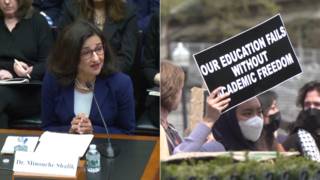
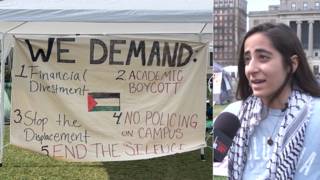
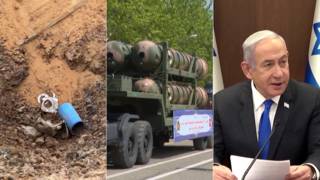





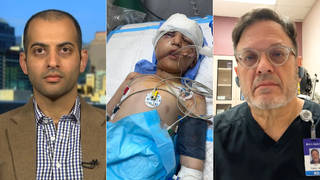
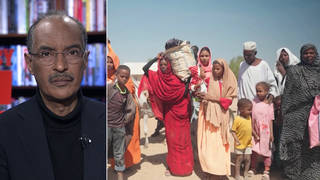
Media Options